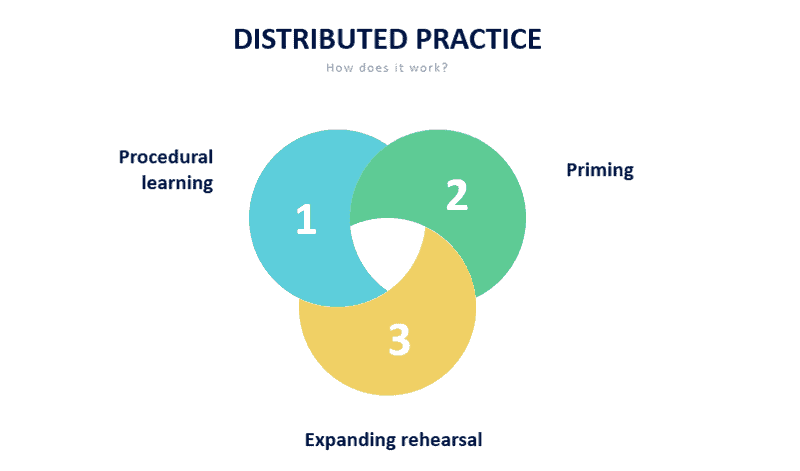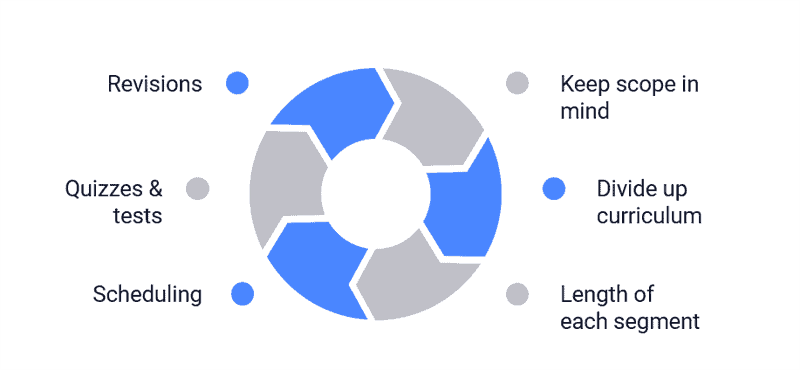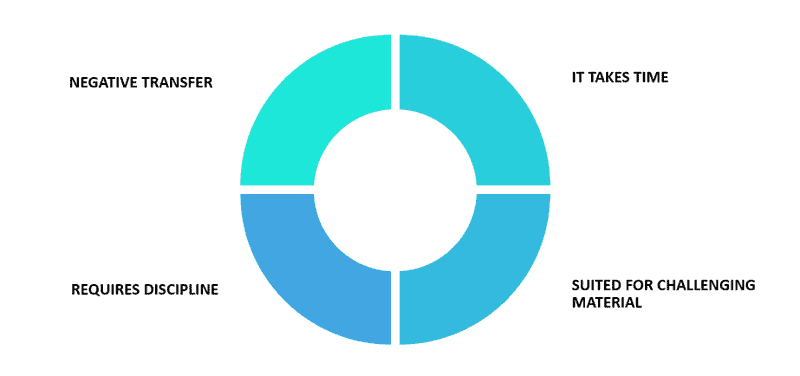Our content is reader supported, which means when you buy from links you click on, we may earn a commission.
Using Distributed Practice in Online Learning

Learning is a lifelong process. From the moment we are born, our interactions with the environment around us govern the mental machinery that drives cognition. As a result, our thoughts, experiences, and senses help nurture our understanding of the world.
When talking about the process of imparting education to students, there have been many historical modes.
The Socratic Method aimed to question students’ underlying axioms about the physical, highlighting inconsistencies and logical fallacies. Subsequent methods stressed the type of education that is best suited for individuals. The objective of these methods changed over time.
Now, most people are under the assumption that education is a means of vocational training; that is, it aims to impart skills with the eventual goal of earning a living.
Students’ cognitive abilities are still under development. As a result, it is common to observe a lag between when education has occurred and when understanding was achieved. Our understanding of education has led us to come up with various pedagogical approaches to learning; however, only a few of them focus on retention. One of them is distributed practice.
What is Distributed Practice?
Distributed practice or spaced practice is a teaching technique where students distribute their learning objectives over time in study sessions. These study sessions are short in duration but are more frequent. In contrast, massed practice is when students do the opposite. They cram all their study material into a few long sessions.
Unfortunately, educational institutions of today are unknowingly promoting massed practice. Instructors feel like they need to finish their syllabus. This leaves little time for students to assess their understanding before moving on.
Plus, tests and quizzes only seek to promote rote memorization, as students tend to prepare for them the night before, cramming all their learning into one study session. This may help during the test as they’ll have a fresh understanding of the material; however, retention only lasts a couple of days.
When comparing massed vs. distributed practice, distributed practice is a far superior mode of learning in the long run. Students who included a study regime based on distributed practice in their learning years are miles ahead of students who chose to go with massed practice.
How does Distributed Practice Work?
Distributed practice was first developed by the German psychologist Hermann Ebbinghaus. His experimentation with memory retention on himself led him towards the discovery of the spacing effect. He used spaced repetition in order to retain knowledge on subjects unknown to him or having little prior knowledge about them.
Distributed practice is about building the psychological processes that govern how memory is retained.

The most commonly used methods of imparting knowledge via distributed means are performed by the following methodologies:
Procedural Learning
When opting for distributed practice, one trains their neural systems so that it doesn’t require the implicit act of attention. The cognition that governs it automatically aligns itself with the activity being performed when repeated often. It’s a sort of muscle memory for the activity being performed or the skill is acquired.
For example, when acquiring a new skill like drumming, instead of beating the drums senselessly, one can take their time to master one aspect of it before moving onto the next one. You could start with just using your legs to beat the bass drum or just the cymbals. The important thing to remember is to start slowly and build up the tempo to the level you want. Then you could opt for doing them together, building the skill up as you go along.
Priming
There is a positive correlation between memory and knowledge gained. Someone can attain more knowledge if they have an excellent system of recall. That’s where priming comes in. It’s when you tune your mind to recall factual information when presented with a stimulus.
By going through text via repetitive sessions, you’ll be able to subconsciously grasp words that denote information about the text and how it fits there. This, in turn, primes your brain to recognize keywords.
Once these keywords are presented later, it serves to drive cognition towards recall. An increase in the number of sessions increases the priming effect, thereby helping you recall effectively and making it a valid point to consider when comparing massed vs. distributed practice.
Expanding Rehearsal
Distributed practice relies on testing for determining the level and scope of knowledge gained. After initial testing, a learner can increase the duration between subsequent tests, as recall increases between each consecutive test.
It doesn’t have to be a written test. Just trying to remember the knowledge gained before a study session can also help in expanding rehearsal and information retrieval, ultimately enhancing the memory pool from which to think and analyze.
How to Include Distributed Practice in eLearning Curriculum
Distance learning via e-learning courses is becoming the new norm of education. Whether you’re studying to enhance your skills in your field, working towards your education, or just for fun, it is one the most efficient ways of learning. It allows you to formulate a custom course tailored to your student’s needs and presents an opportunity to incorporate distributed practice.

Here’s how to incorporate distributed practice into eLearning:
Keep the Scope in Mind
First and foremost, you have to take a look at the content you’re teaching. Not all knowledge is easy to understand for every student and requires a different rate of study sessions. Alternatively, you’ll find some aspects of your course that are easy for learners to grasp. Having this insight will help you employ a distributed practice methodology in your curriculum.
Chalk Out How You’re Going to Divide your Curriculum
Now that you’re aware of the different topics, you can plan how you’re going to divide your curriculum into segments so that each segment teaches a specific aspect of the course. Keep in mind that you should have clear learning objectives from each segment.
Your students will have trouble assimilating future segments if they’re unable to learn the objectives in the segments they’re currently on. This is only assuming that your course aims to build up the knowledge with each section. If it is a standalone segment, then you don’t need to worry about this as much.
Length of Each Segment
In order to share the knowledge of your course effectively, you need to have an idea of the level of understanding students will have during each segment. If you already have an idea based on your experience, then you can skip this step, but if you’re starting from scratch, you need to research elsewhere.
A good place to start would be to compare the length of your course with similar courses. See if they’re already employing a distributed practice approach. If so, let the duration be the same; otherwise, elongate the duration of topics to suit the distributed practice approach.
Also, you need to account for the difficulty level that comes with each topic. Consider segmenting difficult topics further if you can do so without sacrificing coherence. Plus, it doesn’t have to remain the same throughout the course. If you think your students are struggling, it’s best to lengthen the duration of that specific topic. You may find that some topics may be easier to grasp than anticipated; you can adjust them accordingly.
Another thing to keep in mind is that as the number of topics increase, more time will be required by each student to reflect back on what they’ve learned. This implies that the duration between each segment should increase as well. Not only will this help students gain more knowledge, but it also helps them polish expanding rehearsal.
Scheduling
It won’t be distributed practice without ensuring that students adhere to a schedule of learning. That’s why you need to control the access to each segment such that students don’t cram them at the end of the course.
What you can do is give them access to each segment of the course one at a time. They can’t move on to the next segment if they haven’t spent the recommended time going through it or haven’t gone through it the recommended number of times. Once these objectives are met, they gain access to the next segment, but they can’t go back. This will ensure that each student sticks to the schedule and doesn’t deviate from the distributed practice regime.
This can be easily achieved with online training, as everything can be implemented via your online course platform. It’ll give you an indication of where every student is at and help the students choose flexible sessions that work for them.
Add Quizzes and Tests
Quizzes and tests are not for your students. Rather, they are tools for you to gauge how your students fair with the course you’ve created. You can keep them marked or unmarked if you want your students to assess themselves or not. This helps you tweak the topics in your course.
If you find that students are scoring low on a certain segment, then you can adjust it to suit the difficulty. Additionally, it helps you ascertain if your course has the correct flow. Meaning, you can change the progression of topics, adjusting them between segments as you go along. This will help build up your course such that you’ll find the most effective teaching flow.
You can add tests and quizzes wherever you like during the duration of the course, ideally keeping them at the end of each segment. Make sure you don’t flood your students with tests and quizzes, instead try incorporating games.
Gamifying learning outcomes helps incentivize students’ education, plus it provides the necessary stimulus for priming factual information. The end result is memory sharpening for attaining more knowledge.
Revisions
Recall is another crucial aspect of distributed learning. When pinning massed vs. distributed learning against each other, what truly differentiates them is the number of times an individual goes through the material.
The eventual aim here is to introduce a topic the optimal number of times for brief periods so that it becomes a part of muscle memory. The muscle in question is the brain, and memory is cognitive recognition.
Not every topic needs to have the same number of revisions. Again, it depends on the level of difficulty of the syllabus and the cognitive abilities of the student.
Considering that not all students are the same, you need to keep them at an average level so that your online course is inclusive of all who want to take part in it. If any student seems to struggle, you can give them more time.
This has the advantage of allowing each student to study, keeping any limitations with their schedule in mind. Moreover, it prevents the anxiety they may experience when cramming during massed practice sessions.
The Drawbacks of Distributed Practice
Nothing is perfect, not even distributed practice. There are a few drawbacks when using this approach.

Here’s a list of some of them below:
It Takes Time
You must’ve guessed already that distributed practice takes more time to accomplish the same level of learning outcomes that conventional approaches use. However, this is a small price to pay when you consider the long-term retention it offers.
More Suited for Challenging Materials
If you’re teaching introductory lessons for a topic, or simple skills with easy-to-follow instructions, then distributed practice might not be the best approach to use. Topics or segments like these tend to frustrate students if they can already achieve the same level of retention with conventional courses.
Requires Discipline
When going through a topic multiple times, your students may believe that they have sufficiently understood it and may skip further revisions. They’ll most likely forget that the same knowledge is being imparted; however, the goal here is to retain it for longer.
Additionally, skilled students may get de-motivated if they go through the subject matter a number of times, or it might just be plain old boring for them. Hence, students need to be made aware of the methodology being employed and what it means for their recall in the future. This is something that you can’t control and depends entirely on each student.
Hindrances Due to Negative Transfer
Students can become so accustomed to certain concepts and ways of approaching a problem that it may be difficult for them to apply different learning criteria in different situations. For example, a student may become used to solving a math problem in the way shown in your course.
The revisions and recall via the distributed practice methodology can ingrain it in their minds such that it may become challenging to solve the same math problem using easier methods.
Also, if your eLearning courses aren’t planned correctly, or if there is some underlying error that hasn’t been fixed, conflicting topics may serve to derail the learning processes or prolong its outcome.
Where Should You Use Distributed Practice?
There are a number of areas of learning suited for using a distributed practice regime. It’s up to your judgment when it comes to where you want to include it. But you must consider the age group you’re teaching and the level of difficulty they’ll face when going through it.
Languages
Perhaps the best use case for distributed practice is while learning or teaching languages. Other than proper uses of words and remembering sentence structure, the main problem with languages is retaining the vocabulary.
If you can recall words faster, it makes it easier for you to master the rest of the aspects. Including a distributed approach while keeping a focus on priming can help retain more words. Try segmenting similar words together or similar use cases for words. It’ll help instill the required stimulus for recall.
Intermediate to Advanced Level Courses
Distributed practice may be well suited for your online course if students already have some basic knowledge of the subject.
However, it is important to look out for negative transfer as you have no way of knowing what they learned in those courses. To circumvent this problem, you may want to start with an introductory class. Other than that, if you have challenging content to teach, then segmenting your course into modules keeping distributed practice in mind will help.
Courses Requiring Repetitive Tasks
Some courses, like those on learning how to play an instrument, require students to perform an action multiple times before it sits in their memory. Using a distributed approach is the right strategy to employ here as you want to build neural pathways that result in an action. This doesn’t just require cognitive abilities but also training hand-eye coordination.
FAQs on Distributed Practice
How does distributed practice work?
Distributed practice is a term used to describe the spacing out of study sessions over time. When information is spread out over multiple study sessions, it gives your brain time to process and store the information more effectively.
In contrast, cramming everything into one big study session can be counter-productive. Not only will you be more likely to forget what you’ve studied, but you’ll also be more likely to feel overwhelmed and stressed.
What is massed practice vs distributed practice?
When it comes to learning new skills, there are two main approaches that people often take: massed practice and distributed practice. With massed practice, the focus is on cramming as much practice into a short period of time as possible. The thinking is that by doing this, the material will be fresh in your mind and you’ll be able to remember it better when it comes time to use it.
Distributed practice involves spreading out your practice sessions over a longer period of time. The benefit of this approach is that it gives your brain more time to process and learn the material. As a result, you’re more likely to retain the information in the long term.
If you’re trying to learn a complex skill or you don’t have much time for practice, massed practice may be more effective. However, if you’re trying to learn something simple or you have plenty of time for practice, distributed practice may be the better option.
How do you implement distributed practice?
First, try to break up your study material into manageable chunks. For example, if you’re studying for a history test, you might want to focus on one period or topic at a time.
Second, create a schedule that allows you to space out your study sessions. Rather than cramming everything into one night, try studying for an hour each day for several days leading up to the test.
Finally, make sure to give yourself breaks between study sessions so that you don’t get overwhelmed or burned out.
What is distributed practice in learning?
Studies have shown that distributed practice leads to better retention and recall than massed practice, which is when you try to cram all of your studying into a short period of time. Here are a few reasons why it’s more effective:
It gives your brain time to process and assimilate new information.
It allows you to space out your reviewing, which makes it easier to identify gaps in your knowledge and focus on specific areas that need improvement.
It simply makes it easier to stick to a study schedule; it’s much easier to commit to 10 minutes of studying per day than two hours.
Final Word
When comparing massed vs distributed practice, distributed practice is surely the way to go in many cases.
You must have heard of the old adage that practice makes perfect.
The concept is similar; however, in order for it to truly reflect distributed practice, we must amend it to slow, and frequent practice makes perfect.
There’s no definitive way of incorporating distributed practice in your online course; instead, it needs to be perfected with time. It requires patience, resilience, and most of all, the ability to recognize what works and what doesn’t.